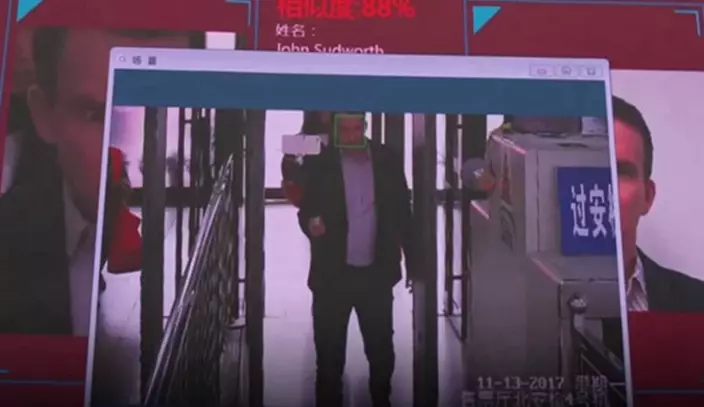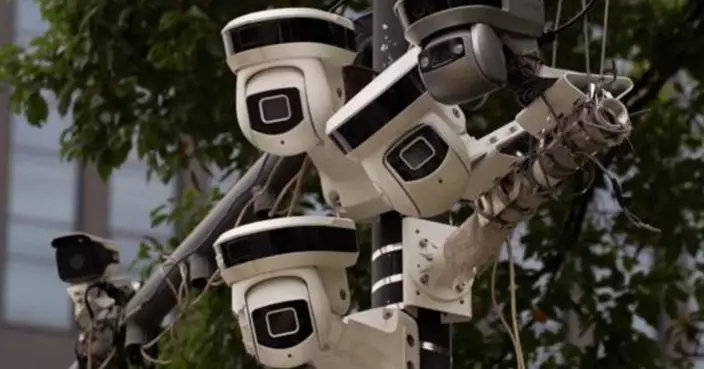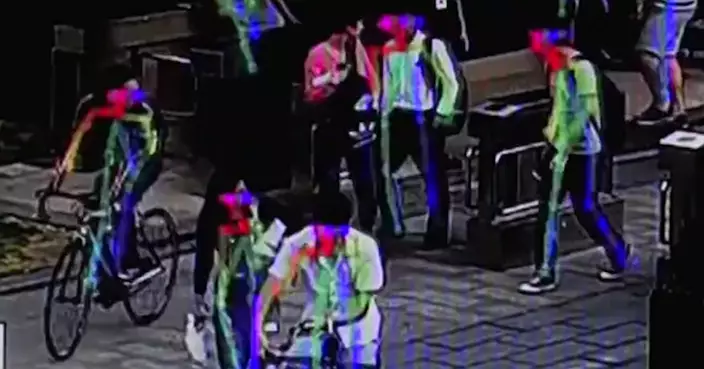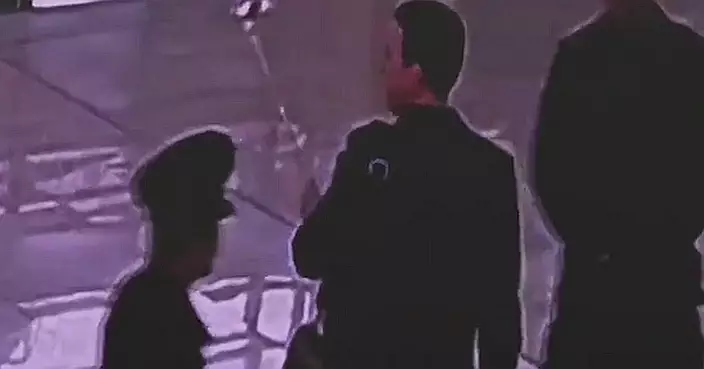A BBC correspondent was spotted by China's surveillance program for public security, the Skynet Project, just seven minutes after he "escaped" during a test in Guiyang City in Guizhou Province, southwest China, on Sunday.

In the test at the public security center, Guiyang police first took a mugshot of correspondent John Sudworth who then put his "escape plan" into motion.
John was going to the city center of Guiyang and headed for the railway station. On his way to the station, he passed by several surveillance cameras on a footbridge.

BBC Photo
After he passed through the security check in the station hall, several police targeted him from behind and the security center matched the image collected at the station with the mugshot stored in the Skynet Project.

BBC Photo
The project is a real-time pedestrian detection and recognition system, which can read faces, gender, age and even ethnicity. According to a surveillance camera producer, the technology, which has racked up sales of one million cameras, can even match every face with an ID card, and trace back people's movements within one week.
Such an advanced and sophisticated system would be expected to incur public concerns over privacy.

The Guiyang police explained that police officers will use the system when people are in need of help.
"If you don't have anything to hide from, there is no need to worry," Sudworth said.

China has about 20 million surveillance cameras which are used to maintain public security and help police track fugitives, according to a China Central Television documentary on society safety.

FRESNO, Calif.--(BUSINESS WIRE)--Dec 17, 2025--
Community West Bancshares (NASDAQ: CWBC), Fresno, California, parent company of Community West Bank and United Security Bancshares (NASDAQ: UBFO), parent company of United Security Bank, Fresno, California, announced today that pursuant to their previously announced definitive merger agreement under which the companies will combine in an all-stock merger transaction, two current directors from United Security Bancshares, Jagroop “Jay” Gill and Dora Westerlund, will be added to Community West Bancshares’ board of directors upon consummation of the merger, subject in each case to compliance with Community West Bancshares’ corporate governance requirements. In connection with the transaction, Mr. Gill, the largest shareholder and Vice Chairman of United Security Bancshares, is expected to be appointed Vice Chairman of Community West Bancshares’ board of directors.
This press release features multimedia. View the full release here: https://www.businesswire.com/news/home/20251217681537/en/
“We look forward to welcoming Jay and Dora to the board,” said Daniel J. Doyle, Chairman of the board of directors of Community West Bancshares and Community West Bank. “Jay and Dora will bring an abundance of leadership and experience to our boardroom, and their guidance will be invaluable as we continue to execute on our ambition to create a more robust and more visible banking franchise while serving communities throughout Central California,” Mr. Doyle continued.
About Community West Bank and Bancshares
Community West Bancshares (NASDAQ: CWBC) and its wholly owned subsidiary, Community West Bank, are headquartered in Fresno, California. The Company was established in 1979 with the vision to help businesses and communities by exceeding expectations at every opportunity, and opened its first Banking Center on January 10, 1980. Today, Community West Bank operates full-service Banking Centers throughout Central California and maintains a variety of departments supporting Commercial Lending, Agribusiness, SBA, Residential Construction and Mortgage, Manufactured Housing, Private Banking and Cash Management.
More information about Community West Bancshares and Community West Bank can be found at www.communitywestbank.com.
About United Security Bank and Bancshares
United Security Bancshares (NASDAQ: UBFO) is the holding company for United Security Bank, which was founded in 1987 and is headquartered in Fresno, California. United Security Bank provides a full range of commercial and personal banking services through a network of 13 full-service branch offices in Fresno, Bakersfield, Campbell, Caruthers, Coalinga, Firebaugh, Fowler, Mendota, Oakhurst, San Joaquin, and Taft. Additionally, United Security Bank operates Commercial Real Estate, Construction, Commercial Lending, and Consumer Lending departments. United Security Bank is dedicated to delivering exceptional service and fostering economic growth in the communities it serves. For more information, please visit www.unitedsecuritybank.com.
ATTACHMENTS:
Additional Information about the Proposed Transaction and Where to Find It
Investors and security holders are urged to carefully review and consider each of Community West Bancshares’ and United Security Bancshares’ public filings with the Securities Exchange Commission (“SEC”), including but not limited to their respective Annual Reports on Form 10-K, their Proxy Statements, Current Reports on Form 8-K and Quarterly Reports on Form 10-Q.
Community West Bancshares documents filed with the SEC may be obtained free of charge at Community West Bank’s website at www.communitywestbank.com, at the SEC’s website at www.sec.gov, requesting them in writing to Community West Bancshares, 7100 N. Financial Drive, Suite 101, Fresno, California 93720; Attention: Investor Relations, or by telephone at (916) 235-4617. United Security Bancshares documents filed with the SEC may be obtained free of charge at United Security Bank’s website at www.unitedsecuritybank.com, at the SEC’s website at www.sec.gov, requesting them in writing to United Security Bancshares, 2126 Inyo Street, Fresno, California 93721; Attention: Investor Relations, or by telephone at (559)490-6261.
Community West Bancshares intends to file a registration statement on Form S-4 with the SEC which will include a joint proxy statement/prospectus which will be distributed to the shareholders of Community West Bancshares and United Security Bancshares in connection with their vote on the proposed merger. Before making any voting or investment decision, investors and security holders of Community West Bancshares and United Security Bancshares are urged to carefully read the entire joint proxy statement/prospectus when it becomes available, as well as any amendments or supplements thereto, because it will contain important information about the proposed merger. Investors and security holders will be able to obtain the joint proxy statement/prospectus free of charge from the SEC’s website or from Community West Bancshares and United Security Bancshares by writing to the addresses provided in the paragraph above.
The directors, executive officers and certain other members of management and employees at Community West Bancshares and United Security Bancshares may be deemed participants in the solicitation of proxies in favor of the merger from their respective shareholders. Information about the directors and executive officers of Community West Bancshares is included in the proxy statement for its 2025 Annual Meeting of Shareholders, which was filed with the SEC on April 4, 2025 and in its Annual Report on Form 10-K for the year ended December 31, 2024 filed with the SEC on March 17, 2025. Information about the directors and executive officers of United Security Bancshares is included in the proxy statement for its 2025 Annual Meeting of Shareholders, which was filed with the SEC on April 7, 2025 and its Annual Report on Form 10-K for the year ended December 31, 2024 filed with the SEC on March 20, 2025.
Forward-Looking Statements – This press release contains certain forward-looking information about Community West Bancshares, United Security Bancshares, and the combined company after the close of the merger and is intended to be covered by the safe harbor for “forward-looking statements” provided by the Private Securities Litigation Reform Act of 1995. All statements other than statements of historical fact are forward-looking statements. Such statements involve inherent risks, uncertainties, and contingencies, many of which are difficult to predict and are generally beyond the control of Community West Bancshares, United Security Bancshares and the combined company. Community West Bancshares and United Security Bancshares caution readers that a number of important factors could cause actual results to differ materially from those expressed in, or implied or projected by, such forward-looking statements. In addition to factors previously disclosed in reports filed by Community West Bancshares and United Security Bancshares with the SEC, risks and uncertainties for each institution and the combined institution include, but are not limited to the ability to complete the merger; government approval may not be obtained or adverse regulatory conditions may be imposed in connection with governmental approvals of the merger; approval by the shareholders of Community West Bancshares or United Security Bancshares may not be obtained; the successful integration of United Security Bancshares, or achieving expected beneficial synergies and/or operating efficiencies, in each case might not be obtained within expected time-frames or at all; the possibility that personnel changes/retention will not proceed as planned; and other risk factors described in documents filed by Community West Bancshares and United Security Bancshares with the SEC. All forward-looking statements included in this press release are based on information available at the time of the communication. Pro forma, projected and estimated numbers are used for illustrative purposes only and are not forecasts, and actual results may differ materially. Community West Bancshares and United Security Bancshares are under no obligation to (and expressly disclaim any such obligation to) update or alter any forward-looking statements, whether as a result of new information, future events or otherwise except as required by law.

Community West Bancshares and United Security Bancshares Announces Pending Additions to Board of Directors
















